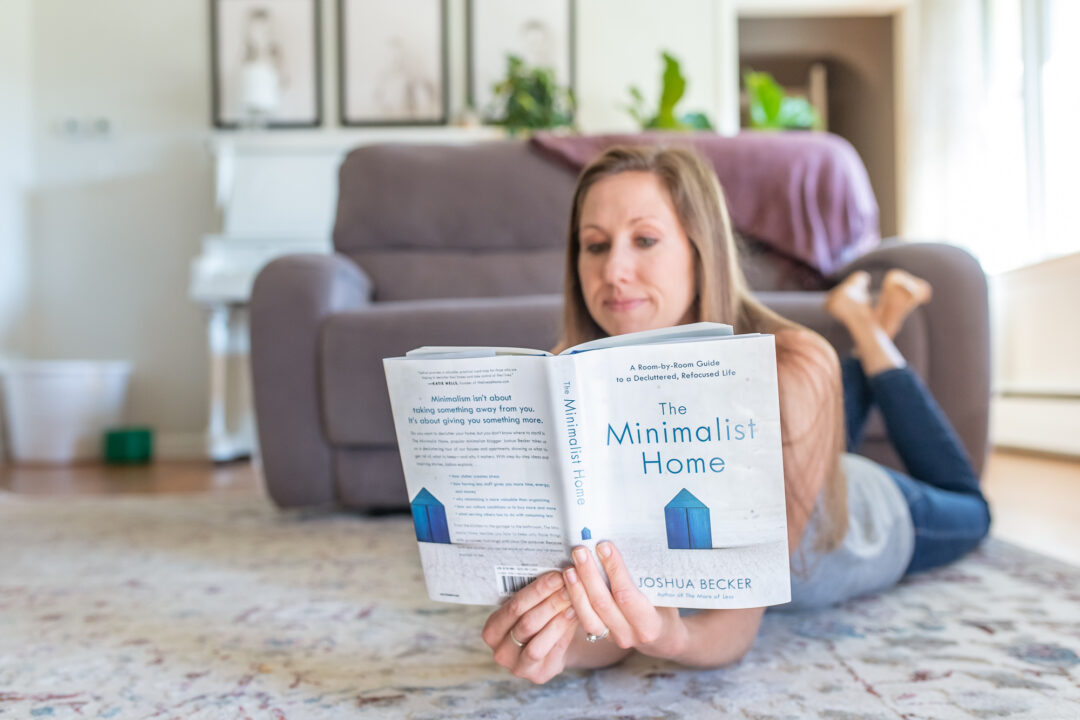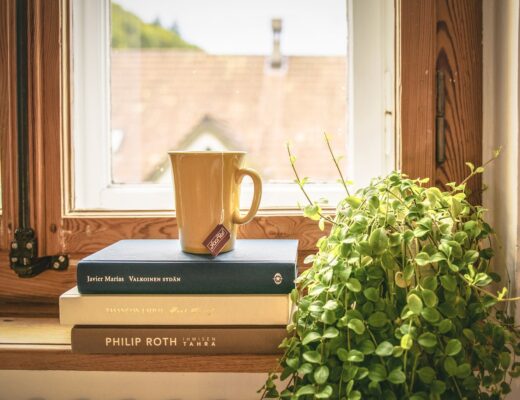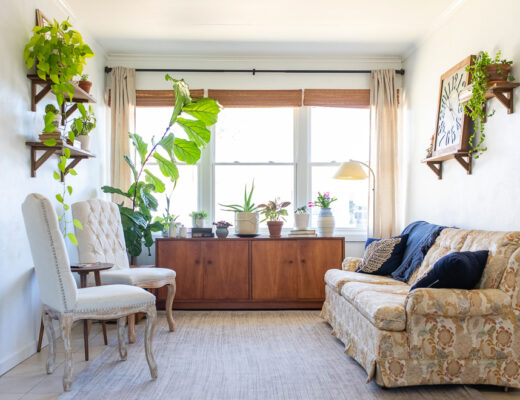Created by Mike & Mollie. Subscribe to our blog.
If you’re a homeowner, chances are you’ve felt the need to declutter and organize at least a time or two in the past year. It’s amazing how items seem to accumulate and pile up, leading to bursting cupboards, closets that contain items we don’t even use, and a nagging sense of overwhelm.
In 2014 when tidying aficionado, Marie Kondo, introduced America to her minimalist method of home decluttering, it inspired a change within many. She encouraged people to hang onto only what sparked joy, by eliminating unnecessary items and decluttering their homes once and for all.
Personally, we’ve seen our own “magic of tidying up” as we’ve learned strategies towards making realistic, sustainable choices of what we bring into our home and how we manage our possessions. Something our college cross country coach always said still rings true with many obstacles of life–
“It’s not rocket science, it’s consistency”.
This same thought applies to keeping our homes clutter-free. There’s no grand, complicated theory that takes a college degree to understand. But recognizing some simple habits, letting go of unnecessary items, and having the will-power to consistently implement those routines have been some of our most valuable keys to success.
Last month, I picked up Joshua Becker’s best selling book, The Minimalist Home. As a regular follower of his blog, Becoming Minimalist, I was well-versed in many of his ideas about seeking out a minimalist lifestyle. In this book, he speaks of how to turn your home into a place where peace and contentment are found and where purposeful living is emulated.
Whether it be through telling the story of his own minimalist journey, his simple room-by-room approach towards decluttering, or the effectiveness of “The Becker Method”, I greatly enjoyed reading his book. We’ve implemented many of the simplifying habits that he writes about in this book as well as in his blog posts, which I wanted to share through this post.
We’re only about one year into our simplifying journey, so we still remember (and continue to face) obstacles with keeping our home clutter-free and limited from an excess of “stuff”. In this blog post, you’ll find a series of common questions that many ask when tackling the task of simplifying their lives and decluttering their homes. As a response, I’ve used my own experience with this process as well as helpful, meaningful insights that I’ve read about in The Minimalist Home.
Q: I’ve heard the terms “minimalism” and “minimalist” thrown around many times, but what does it really mean?
A: There can be many definitions of the words “minimalism” and “minimalist” since everyone’s approach and goals are different. For us, minimalism means reducing the amount of unnecessary items in our life to make room for more of what we truly value. For example, we limit the amount of toys our kids have in their playroom. There are many reasons why we do this, but one is to decrease the amount of time it takes us to tidy up each day so that we have more time to spend doing things we enjoy– such as heading out after dinner for a bike ride or playing baseball in the yard.
Q: One of the main paths to minimalism is to own less. But how do I really know what to get rid of and what to keep? Should I really be asking myself the question “does it spark joy” (as famously said by Marie Kondo)?
A: I believe that minimalism should focus less on just getting rid of “stuff” and more about creating a lifestyle that allows you to be intentional about what you own. I don’t have a set number of kitchen utensils or clothes in my closet, but I’m always asking myself if what’s in my house continues to serve a purpose in this season of life. There can be many items in your home that spark joy, but if they’re just taking up space and causing clutter, maybe it’s time to let them go.
Q: How is owning less actually beneficial?
A: There are many ways that owning less has made our life more beneficial and less burdensome. We have less items to return back to their “homes” each evening, fewer choices to make (especially with clothing), and feel less overwhelmed with the amount of “stuff” in each room of our home. One of the biggest advantages of owning less has been that I’ve learned to place items in their designated locations more easily.
In The Minimalist Home, Joshua Becker writes:,
“Over the course of an average lifetime, because of all the clutter we live in, we will spend 3,680 hours, or 153 days, searching for misplaced items.”
Q: The thought of decluttering seems overwhelming. Where should I even begin?
A: Decluttering can be overwhelming but it’s much more manageable (and even somewhat enjoyable!) when you break it down into smaller pieces rather than trying to tackle the whole home at once. Joshua Becker says the simplest way to begin decluttering is to start at the easiest place possible by building small victories. For us, an easy place to start is our desk, the car, or a cabinet.
Begin with small spaces, let the motivation of success fuel you, and move onto the next space.
Q: As I use this process of going room by room to declutter, what’s the easiest way of deciding what stays and what goes?
A: For us, Mike has a much easier time decluttering than I do (probably because he’s less attached to sentimental items), but I’ve learned some beneficial tips that I now remind myself each time I minimize a space. Instead of just looking at my closet or inside a drawer, I take everything out of that area. This allows me to physically handle each item before placing it back inside. It also gives me an excuse to give a quick cleaning of the space too.
Before placing the item back, I ask myself a simple question– “Do I need this?”. If it still serves a purpose and I regularly use it, I keep it. If I haven’t used it over the course of the past year, I don’t hang onto it. Limiting my “just in case items” has been a huge way for me to reduce the amount of items in my closet and kitchen.
Q: But what if I feel too guilty getting rid of my “just in case” items?
A: A few years ago after we did a huge decluttering of the kitchen cabinets, I had a table full of utensils and small appliances that I didn’t really use anymore, but thought maybe I should hang onto them “just in case”. I wanted to get rid of them, but felt guilty at the thought of regretting my decision. Like the waffle iron that I hadn’t used once in the past 5 years, but thought one day I might have the desire to make waffles for breakfast.
So I found an empty plastic bin, placed all the items inside, and tucked that bin in the attic. That way, these items were out of sight and I could decide if I really needed them over the next few months. I did go back and remove a few items from my “just in case” bin but for the most part those items remained untouched, so I donated them later that year.
Today, I don’t have as much difficulty hanging onto items “just in case”. I know what I use and donate or sell the rest. We no longer have cupboards that are crammed full, bursting clothing closets, and bins and bins of seasonal decorations stored in our basement.
Q: I’ve heard the ideas of a “capsule wardrobe” or “thinned out closet”. What does that look like?
A: In the 1970’s, London boutique owner Susie Faux coined the term “capsule wardrobe”. She believed that a capsule wardrobe should contain a limited number of staple pieces that you can wear for multiple seasons. Today, many people refer to a capsule wardrobe as being made up of a small number of pieces that can be worn over and over again in different combinations. There are many ways to create a capsule wardrobe, one of the most well known being Project 333, where you collect 33 favorite items in your closet and wear only those for 3 months.
Q: What are the benefits of thinning out my closet and owning less options?
A: For me, I’ve seen huge benefits from greatly decreasing the amount of items I have in my closet.
I can more easily see what I have inside.
I have less overwhelm when making a decision of what to wear.
I no longer tell myself “I have nothing to wear”, because I wear every item in my closet, rather than having those favorite items hidden among the midst of things that were just taking up space.
This may not appeal to everyone, but I don’t mind wearing the same outfits on a weekly basis. It’s an easy decision to make knowing that I have good-fitting, comfortable clothing and shoe options.
Earlier this year, Mike and I decluttered our closets again (I recommend doing this once a year). We donated about 6 garbage bags of clothes, suits, bridesmaid dresses, jackets, shoes, and accessories that we knew we no longer needed to keep. It’s a freeing experience to let go of pieces that no longer serve a purpose to make room for what does matter.
🌿 Introducing, Declutter Your Life, a premium newsletter with monthly challenges to help you live a less cluttered life– inside and out.




